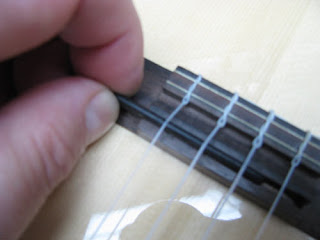 The main issue here is the action is pretty high. Not too unusual for a factory-built ukulele. Some of my friends also have Marcy models, and the action really varies. I've played about one out of five or six that was decent out of the box.
The main issue here is the action is pretty high. Not too unusual for a factory-built ukulele. Some of my friends also have Marcy models, and the action really varies. I've played about one out of five or six that was decent out of the box. I also want to change the factory Aquila strings for Worth browns.
I really like unbleached bone saddles on my ukuleles and guitars. The stock saddle on this uku is ebony. This is actually a good thing - old Martins used ebony, and it's a hard, dense wood that makes a good saddle. A lot of cheap ukuleles use plastic, which is a well-known tone sucker. I was pleasantly surprised to see an ebony saddle here.
But I don't want to hack it up, so it's easier for me just to make a bone saddle that will lower the action and sound good.
First order of business is to trace the basic shape of the old saddle onto a new bone blank.
Then it's file, file, file, until I get the height right. This is a bit of a trial-and-error process. I know I need a few millimeters off the bottom of the new saddle to lower the action. So my approach is to shape it into more or less the same size as the original, put it on the uku, and then file down the height until it's where I want it.
I have more details on the whole process in my post about my Alvarez travel guitar.
Here the new saddle (left) is about the same height as the old. I just file the top until it has the same curvature as the old, then fine tune it from there.
After the saddle is shaped and is a good height, I take a nut file and lower the string height at the nut. You need to proceed with caution here - taking out too much material will cause string buzz. Nylon strings are more flexible than steel strings, so I just take a few strokes, check the height, etc., until it's good.
The nut is also ebony, and looks really great.
After the setup, the uku plays great! I think it also sounds better with the bone nut as well.








0 comments:
Post a Comment